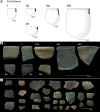Late shellmound occupation in southern Brazil: A multi-proxy study of the Galheta IV archaeological site
- PMID: 38512858
- PMCID: PMC10956814
- DOI: 10.1371/journal.pone.0300684
Late shellmound occupation in southern Brazil: A multi-proxy study of the Galheta IV archaeological site
Abstract
Brazilian coastal archaeology is renowned for its numerous and large shellmounds (sambaquis), which had been continuously occupied from at least 8000 to 1000 years cal BP. However, changes in their structure and material culture in the late Holocene have led to different hypotheses concerning their ecological and cultural changes. The archaeological site Galheta IV (ca. 1300 to 500 years cal BP) offers new insights into the complexity of the late coastal occupation in southern Brazil. Our attempt was to determine whether Galheta IV can be classified as a sambaqui site, or if it belongs to a Southern proto-Jê settlement. Here, we reassessed Galheta's collections and applied a multi-proxy approach using: new 14C dates, zooarchaeology, δ13C and δ15N isotopes in bulk collagen and 87Sr/86Srenamel isotopic ratios from eight human individuals, ceramics analysis, and FTIR. The results indicate an intense exploitation of marine resources, with an area designated for processing animals located at the opposite side of the funerary areas. Bone tools and specific species of animals were found as burial accompaniments. No evidence of human cremations was detected. 87Sr/86Sr results indicate that the eight human individuals always lived on the coast, and did not come from the inland. The pottery analysis confirms the association with Itararé-Taquara, but contrary to what was assumed by previous studies, the pottery seems related to other coastal sites, and not to the highlands. In light of these findings, we propose that Galheta IV can be considered a funerary mound resulting from long and continuous interactions between shellmound and Southern proto-Jê populations. This study not only enhances our understanding of the late coastal occupation dynamics in southern Brazil but also underscores its importance in reshaping current interpretations of shellmound cultural changes over time.
Copyright: © 2024 Mendes Cardoso et al. This is an open access article distributed under the terms of the Creative Commons Attribution License, which permits unrestricted use, distribution, and reproduction in any medium, provided the original author and source are credited.
Conflict of interest statement
The authors have declared that no competing interests exist.
Figures










Similar articles
-
Testing Late Bronze Age mobility in southern Sweden in the light of a new multi-proxy strontium isotope baseline of Scania.PLoS One. 2021 Apr 21;16(4):e0250279. doi: 10.1371/journal.pone.0250279. eCollection 2021. PLoS One. 2021. PMID: 33882110 Free PMC article.
-
Human mobility on the Brazilian coast: an analysis of strontium isotopes in archaeological human remains from Forte Marechal Luz Sambaqui.An Acad Bras Cienc. 2011 Jun;83(2):731-43. doi: 10.1590/s0001-37652011000200030. An Acad Bras Cienc. 2011. PMID: 21670891
-
Long-term resilience of late holocene coastal subsistence system in Southeastern South america.PLoS One. 2014 Apr 9;9(4):e93854. doi: 10.1371/journal.pone.0093854. eCollection 2014. PLoS One. 2014. PMID: 24718458 Free PMC article.
-
Brief communication: A re-evaluation of the health index of southern Brazilian shellmound populations.Am J Phys Anthropol. 2018 Feb;165(2):353-362. doi: 10.1002/ajpa.23346. Epub 2017 Nov 1. Am J Phys Anthropol. 2018. PMID: 29090738
-
Paleoamerican diet, migration and morphology in Brazil: archaeological complexity of the earliest Americans.PLoS One. 2011;6(9):e23962. doi: 10.1371/journal.pone.0023962. Epub 2011 Sep 14. PLoS One. 2011. PMID: 21935369 Free PMC article.
References
-
- Erlandson JM. The archaeology of aquatic adaptations: paradigms for a new millennium. Journal of Archaeological Research. 2001;9:287–350.
-
- Marean CW. Coastal South Africa and the coevolution of the modern human lineage and the coastal adaptation. Trekking the shore: changing coastlines and the antiquity of coastal settlement. 2011;421–40.
-
- Gaspar MD, DeBlasis P, Fish SK, Fish PR. Sambaqui [shell mound] societies of coastal Brazil. In: The handbook of South American archaeology. Springer; 2008. p. 319–35.
MeSH terms
Substances
LinkOut - more resources
Full Text Sources

